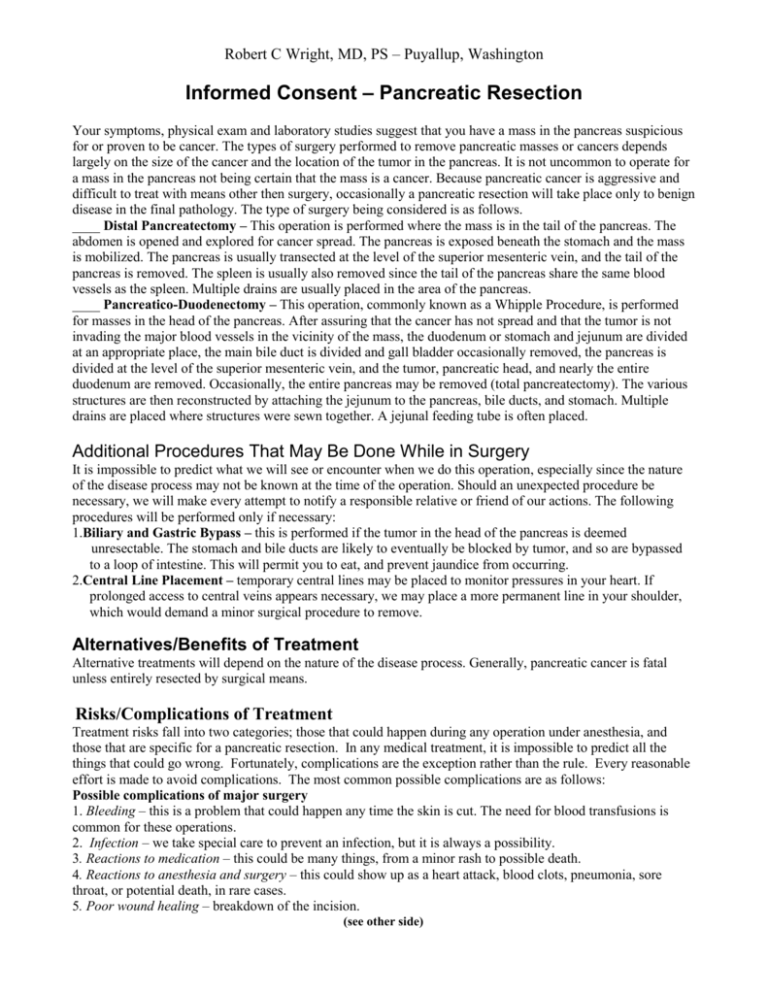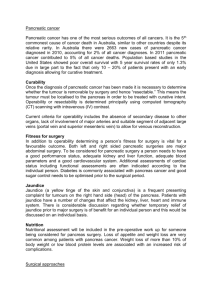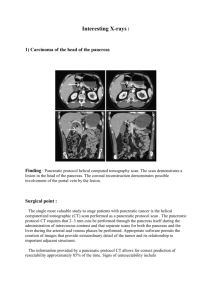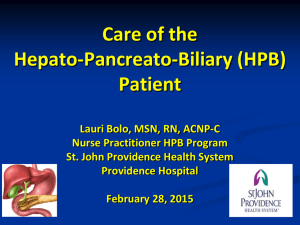Pancreatic Resection
advertisement

Robert C Wright, MD, PS – Puyallup, Washington Informed Consent – Pancreatic Resection Your symptoms, physical exam and laboratory studies suggest that you have a mass in the pancreas suspicious for or proven to be cancer. The types of surgery performed to remove pancreatic masses or cancers depends largely on the size of the cancer and the location of the tumor in the pancreas. It is not uncommon to operate for a mass in the pancreas not being certain that the mass is a cancer. Because pancreatic cancer is aggressive and difficult to treat with means other then surgery, occasionally a pancreatic resection will take place only to benign disease in the final pathology. The type of surgery being considered is as follows. ____ Distal Pancreatectomy – This operation is performed where the mass is in the tail of the pancreas. The abdomen is opened and explored for cancer spread. The pancreas is exposed beneath the stomach and the mass is mobilized. The pancreas is usually transected at the level of the superior mesenteric vein, and the tail of the pancreas is removed. The spleen is usually also removed since the tail of the pancreas share the same blood vessels as the spleen. Multiple drains are usually placed in the area of the pancreas. ____ Pancreatico-Duodenectomy – This operation, commonly known as a Whipple Procedure, is performed for masses in the head of the pancreas. After assuring that the cancer has not spread and that the tumor is not invading the major blood vessels in the vicinity of the mass, the duodenum or stomach and jejunum are divided at an appropriate place, the main bile duct is divided and gall bladder occasionally removed, the pancreas is divided at the level of the superior mesenteric vein, and the tumor, pancreatic head, and nearly the entire duodenum are removed. Occasionally, the entire pancreas may be removed (total pancreatectomy). The various structures are then reconstructed by attaching the jejunum to the pancreas, bile ducts, and stomach. Multiple drains are placed where structures were sewn together. A jejunal feeding tube is often placed. Additional Procedures That May Be Done While in Surgery It is impossible to predict what we will see or encounter when we do this operation, especially since the nature of the disease process may not be known at the time of the operation. Should an unexpected procedure be necessary, we will make every attempt to notify a responsible relative or friend of our actions. The following procedures will be performed only if necessary: 1.Biliary and Gastric Bypass – this is performed if the tumor in the head of the pancreas is deemed unresectable. The stomach and bile ducts are likely to eventually be blocked by tumor, and so are bypassed to a loop of intestine. This will permit you to eat, and prevent jaundice from occurring. 2.Central Line Placement – temporary central lines may be placed to monitor pressures in your heart. If prolonged access to central veins appears necessary, we may place a more permanent line in your shoulder, which would demand a minor surgical procedure to remove. Alternatives/Benefits of Treatment Alternative treatments will depend on the nature of the disease process. Generally, pancreatic cancer is fatal unless entirely resected by surgical means. Risks/Complications of Treatment Treatment risks fall into two categories; those that could happen during any operation under anesthesia, and those that are specific for a pancreatic resection. In any medical treatment, it is impossible to predict all the things that could go wrong. Fortunately, complications are the exception rather than the rule. Every reasonable effort is made to avoid complications. The most common possible complications are as follows: Possible complications of major surgery 1. Bleeding – this is a problem that could happen any time the skin is cut. The need for blood transfusions is common for these operations. 2. Infection – we take special care to prevent an infection, but it is always a possibility. 3. Reactions to medication – this could be many things, from a minor rash to possible death. 4. Reactions to anesthesia and surgery – this could show up as a heart attack, blood clots, pneumonia, sore throat, or potential death, in rare cases. 5. Poor wound healing – breakdown of the incision. (see other side) Possible complications of a pancreatic resection 1. Pancreatic leak – this will result in either an abdominal fluid collection or a large amount of drainage into one of the drains. Re-operation may occasionally be necessary. 2. Leak from the gastric, biliary, or pancreatic anastamoses – this may entail prolonged treatment including a length of time being fed only by vein, and possibly re-operation to resolve. Drainage tubes may be required. Prolonged dependence on a feeding tube could occur. 3. Pancreatic insufficiency – diabetes —because the pancreas makes insulin, you may require insulin following this operation. 4.Pancreatic insufficiency – digestive enzymes – you may have a problem with diarrhea or weight loss following surgery which would be because of insufficient digestive enzymes being secreted by the pancreas. These will then need to be replaced in the diet. 5.Cancer recurrence – Pancreatic cancer may come back in the abdomen or may spread to other parts of the body, in spite of a successful operation. Anticipated Recovery/Expected Rehabilitation Recovery is quite variable, depending on the individual. You will possibly be in intensive care for one or two days, but encouraged to get up and moving as quickly as possible. Hospitalization lasts for 10 days to 20 days. It will take several months before you are able to do things independently. Most people require about three months before they are able to return to work. If your final diagnosis after surgery is cancer, further treatment may be required, including chemotherapy and possibly radiation therapy. The final pathology report after surgery will influence this decision. Consent for Treatment I understand my condition to be a problem with my pancreas, and am aware of its risks if untreated. I have read and understand the above explanation of the operation required. My surgeon has answered my questions, and I choose to proceed with surgery. I understand that every operation may yield unexpected findings. I give the surgeon permission to act on his best judgment in deciding to remove or biopsy tissues that appear to be diseased, understanding that complications may arise from that action. I understand that while most people receiving surgery to the pancreas may benefit from this operation, I may not. My condition may not improve, and it may worsen. No absolute guarantee can be made. HIPAA: Before and after surgery, unless otherwise requested in writing by you, visitors whom you invite to attend the surgery will be informed of the surgical finding, your surgical status, and anticipated recovery issues, for effectiveness of communications. Because of the anesthetic, you may or may not remember these important details PRINT NAME__________________________________________________________________________ SIGNATURE ______________________________________________ DATE _________________ WITNESS ________________________________________________ DATE _________________ SURGEON ________________________________________________ DATE _________________ RELATIONSHIP TO PATIENT IF SIGNATURE OF LEGAL GUARDIAN ________________________________ I waive the right to read this form, and do not want to be educated and informed of treatment risks; nonetheless I understand the need for this surgery and grant permission to the surgeon to proceed on my behalf. SIGNATURE _____________________________________________________ DATE ______________ Rev11/04pjd











